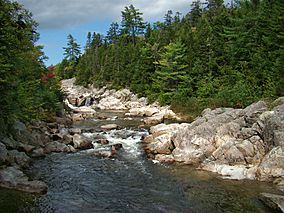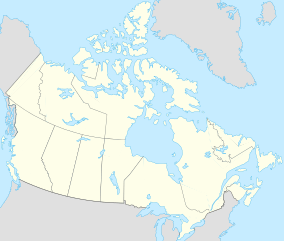Fundy National Park facts for kids
Quick facts for kids Fundy National ParkParc national de Fundy (French) |
|
|---|---|
|
IUCN Category II (National Park)
|
|

The Moosehorn Trail
|
|
| Location | Alma, New Brunswick, Canada |
| Area | 207 km2 (80 sq mi) |
| Established | 1948 |
| Visitors | 281,289 (in 2015–16) |
| Governing body | Parks Canada |
Fundy National Park is a special place in Canada. It is a national park located in New Brunswick, right next to the amazing Bay of Fundy. The park officially opened on July 29, 1950.
This park is famous for its rough coastline and the world's highest tides. Imagine the ocean floor appearing and disappearing twice a day! It also has more than 25 beautiful waterfalls. Fundy National Park covers about 207 square kilometers (80 square miles). It stretches along Goose Bay, which is part of the Bay of Fundy. From the park, you can even see the coast of Nova Scotia across the bay.
When the tide is low, visitors can walk on the ocean floor. You might see sea creatures like dog whelks and periwinkles. Many types of seaweed also cling to the rocks. When the tide comes in, the ocean floor disappears under 15 meters (50 feet) of salty water.
Contents
Fun Things to Do in Fundy Park
Fundy National Park offers many exciting activities for visitors. It's a great place to explore nature and have an adventure.
Hiking and Biking Trails
The park has over 100 kilometers (62 miles) of trails. You can go hiking or biking on these paths. There are 25 different hiking trails to choose from. The Caribou Plains trail has a boardwalk. It takes you through forests and bog areas. Dickson Falls is one of the most popular trails. It leads to a beautiful waterfall.
Park Facilities
Fundy National Park has many things to make your visit comfortable. There is a golf course where you can play. You can also swim in a heated saltwater swimming pool. If you want to stay overnight, there are three campgrounds available.
Winter Activities
Even in winter, Fundy National Park is open for fun. You can go cross-country skiing on groomed trails. Many people also enjoy snowshoeing, tobogganing, and winter walking. Just remember to be safe, as it's for day use at your own risk.
Exploring Beyond the Park
Two famous trails start from the park. The Dobson Trail goes towards Riverview. The Fundy Footpath leads to St. Martins. You can also see a unique red covered bridge at Point Wolfe.
Rivers in the Park
Several rivers flow through Fundy National Park. These include the:
- Broad River
- Point Wolfe River
- Upper Salmon River
Nature and Wildlife
Fundy National Park is home to many different plants and animals. It's a great place to learn about nature.
Forests and Plants
The park has different types of forests. The southern part has cool, wet summers and mild, rainy winters. Its forests have red spruce, balsam fir, and red maple trees. You can also find white spruce, white birch, and yellow birch. Some sugar maple and beech trees grow at higher places.
The northern part of the park has warm, rainy summers and mild, snowy winters. Its forests have a mix of trees. These include sugar maple, red maple, white spruce, and balsam fir.
Overall, the park has 658 types of vascular plants. It also has 276 types of bryophytes (like mosses). More than 400 types of lichens grow here too. The forest floor is often covered with moss, wood fern, and bunchberry.
Special Trees and Flowers
Some parts of the forest have mostly one type of hardwood tree. Yellow birch and white birch are common. You can also find stands of sugar maple, red maple, and beech trees. In spring, beautiful flowers like Carolina springbeauty and trout-lily bloom in these hardwood forests.
The park also has some of the last pure stands of red spruce in eastern North America. These are special conifer trees.
Bog Plants
The park has bogs, which are wet, spongy areas. They are covered with sphagnum moss. Black spruce and Eastern larch trees grow there. In the Caribou Plain bog, you can find three types of carnivorous plants! These are the pitcher plant, sundew, and bladderwort. These plants eat insects.
Rare Plants
Some rare plants also live in the park. The Bird’s-eye primrose grows along the coastal cliffs. Other rare plants include slender spikemoss and squashberry. You can find these along the Point Wolfe River and Bennett Brook.
Amazing Animals of Fundy Park
Fundy National Park is home to many different animals. You might spot some of these creatures during your visit:
- Moose
- Snowshoe hares
- Chipmunks
- Cormorants
- Red squirrels
- Pileated woodpeckers
- Little brown bats
- Peregrine falcons
- Black bears
- Coyotes
- Beavers
- White-tailed deer
- White-winged crossbills
- Various mice and shrews
- Juncos
- Sandpipers
- Raccoons
- Warblers
- Plovers
- Great blue herons
- Northern flying squirrels
Scientists in the park keep an eye on many animals. They monitor species like the endangered Inner Bay of Fundy Salmon. They also track martens and fishers, which are part of the weasel family. Brook trout, eels, and moose are also regularly watched. This helps protect the park's wildlife.
Park Management and Visitors
Fundy National Park is managed by Parks Canada. This is a government agency that looks after Canada's national parks.
How Many People Visit?
In 2012-2013, about 240,481 people visited Fundy National Park. It is the most visited Parks Canada site in New Brunswick. Many visitors come from New Brunswick itself. Others come from nearby provinces like Nova Scotia and Prince Edward Island. About half of the visitors come from outside the Maritimes region.
Park History
When the park was created, it included several small communities. These areas became part of the park. Some of these communities were:
- Hastings
- Upper Salmon River
- Butland Settlement
Gallery
Images for kids
See also
 In Spanish: Parque nacional Fundy para niños
In Spanish: Parque nacional Fundy para niños











